Preserving biodiversity
Establishment of Biodiversity Action Guidelines for Living in Harmony with Nature
We revised our environmental policy in 2017, adding items for biodiversity and establishing our "Biodiversity Action Guidelines." We will be mindfully avoiding or minimizing our impact on biodiversity within all of our business activities, and aim to maintain the ecosystem and achieve the sustainable use of natural resources in areas along our railway lines.
Nankai Electric Railway Biodiversity Action Guidelines
Aside from water and air, we receive blessings from nature in every aspect of our lives. Therefore, we must live in harmony with nature if we want to build a sustainable society. We believe that improving environmental value based on nature preservation in the areas along our railway lines is one of our business foundations, as well as our mission.
Many creatures and their diverse habitats are in that nature; in other words, it is supported by biodiversity.
We have established action guidelines to respect, protect, and develop biodiversity.
We will position the conservation of biodiversity as a material environmental issue and proactively work to live in harmony with nature.
To avoid or reduce the impact from all our business activities on biodiversity, we will strive to understand and apply relevant laws correctly.
In consideration of the impact of using resources on biodiversity, we will promote green procurement, 3R (reduce, reuse, and recycle), and other environmental activities to reduce environmental stress.
We will value communication with many stakeholders (including customers, our business partners, and people living in the areas along our railway lines and near our business locations), and strive to preserve biodiversity together.
Designated on September 30, 2017
Our approach to biodiversity
To support biodiversity in areas along our rail lines, since 2008 we have been actively contributing to the creation of a society that fosters biodiversity by making donations to the Osaka Biodiversity Conservation Fund.
In 2023, we endorsed the “Osaka Declaration of Support for Biodiversity” and the “Keidanren Declaration on Biodiversity,” and in 2024 we joined the “30 by 30 Alliance for Biodiversity” and the “TNFD Forum."
Promoting green procurement (Green Procurement Guidelines)
When purchasing products for our business activities, we prioritize those with as little environmental stress as possible. Since FY2009, we have been setting targets every year for products purchased online (such as office supplies purchased via the Internet from the PC, etc.) and offline (office supplies ordered by the person in charge of materials in the Accounting & Finance Department) as our green purchase.
In FY2020, we conducted a questionnaire with 100 out of our approximately 300 business partners to monitor the state of their environmental initiatives and for continuous communication. Approximately 25% of our business partners did not have an environmental policy nor a responsible or managing division, so we have requested for their cooperation in green procurement.
Green Procurement Guidelines
1. Purpose
We have established an Environmental Philosophy and Environmental Policy to actively reduce environmental stress and protect the environment, and established the Green Procurement Guidelines as part of the effort.
These guidelines specify mandatory green procurement requirements and objectives for business partners from whom we procure materials. The purpose is to work together to promote procurement while considering the environmental impact.
2. Scope of application
These guidelines shall apply to the materials, products, etc., (hereinafter, “materials”) procured by Nankai Electric Railway.
3. Guidelines
We urge our business partners to understand our Environmental Philosophy, Environmental Policy, and Biodiversity Action Guidelines and to cooperate in our initiatives.
[Requirements for business partners]
Compliance with environmental laws and anti-pollution laws and regulations.
Delivered materials shall not include illegal chemicals.
Delivered materials shall use as little legally restricted chemicals as possible.
A safety data sheet (SDS) shall be submitted if delivered materials include chemicals with greenhouse gas emissions that need to be monitored, etc., as stipulated by the law.
[Objectives for business partners]
Information disclosure
Environmental management system
Develop an environmental management system.
Saving resources and energy, and conserving water resources
DSave the energy used for materials, make them smaller and lighter, and use less water for them.
Packaging and wrapping
Use minimum packaging and wrapping materials, and adopt reusable structures.
Use of resources and reducing waste
Design products that are easy to repair and last a long time.
Use easily recyclable materials and structures that can be easily taken apart.
Disclose any information we request, such as how materials are recycled and disposed of, as much as possible.
[Other]
This guideline will be updated as needed, along with any change in the society, technological developments, revision of laws, etc.
Risk assessment and addressing issues in the supply chain
In FY2020–FY2021, we conducted a questionnaire with 100 of our approximately 440 business partners who supply us with railroad materials and equipment, to monitor the status of their environmental initiatives and to facilitate ongoing communication. Approximately 25% of our business partners did not have an environmental policy or had not yet determined the department in charge or the department with primary responsibility, so we encouraged them to enhance their environmental activities.
In FY2022, we incorporated our initiatives into the newly established Nankai Group Material Procurement Policy.
Click here to see the Nankai Group Material Procurement Policy and our response to risk assessments and supply chain issues.
Status of internal training and other initiatives
In principle, training for purchasing staff takes place once a year to provide education on basic knowledge, including important items of the Nankai Group Material Procurement Policy. In addition, as part of our participation in sustainability initiatives, we endorsed the “Partnership Building Declaration” promoted by the government and economic organizations, and announced it in April 2022. We are promoting cooperation and coexistence with suppliers in the supply chain with the aim of building new partnerships.
The contribution of "Parks Garden" to urban biodiversity
The "Parks Garden" situated on the rooftop of "Namba Parks" (11,500 m2) offers approximately 500 species and 100,000 medium to tall trees, which are home to a variety of bird and insect life. It is a unique place within the city of Osaka that contributes to biodiversity. The "Parks Garden" has been featured as an example of"creating new liveliness through greenery" in the Ministry of the Environment’s "Case studies of collaboration between developers and local communities: Realizing SDGs through development projects." Furthermore, "Parks Garden" was ranked No. 1 in the "Otherworldly Green Rooftop Gardens," a feature in the NIKKEI Plus 1 article published on June 4, 2022 in the Nikkei Keizai Shimbun.
For more information about Parks Garden, click here.
http://www.nambaparks.com/parks_garden.html
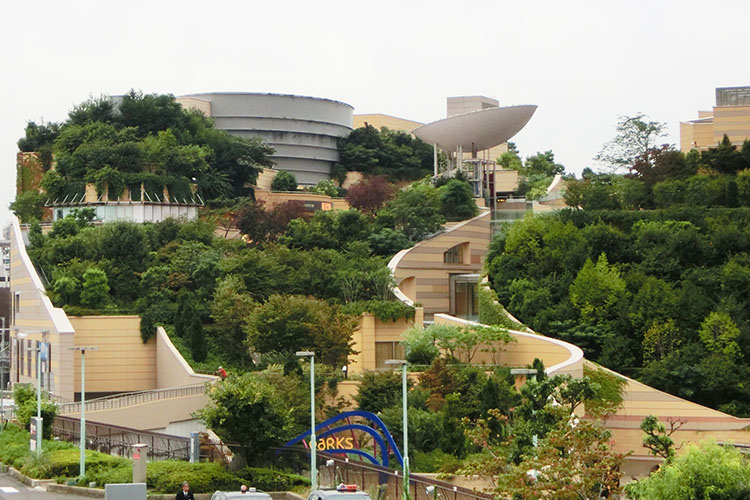
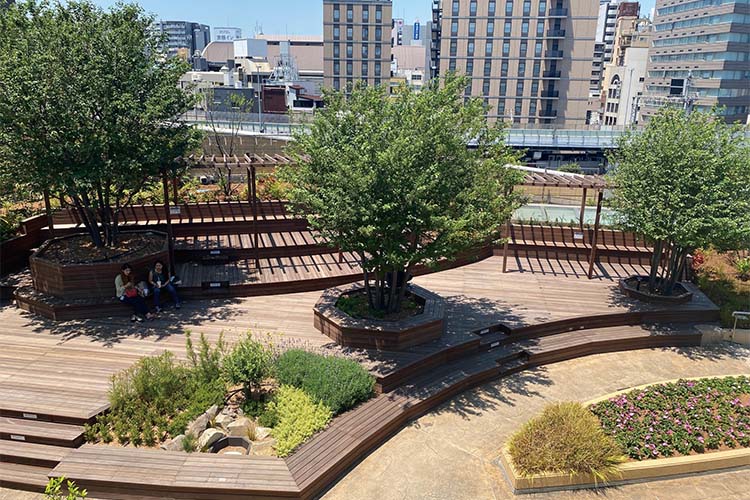
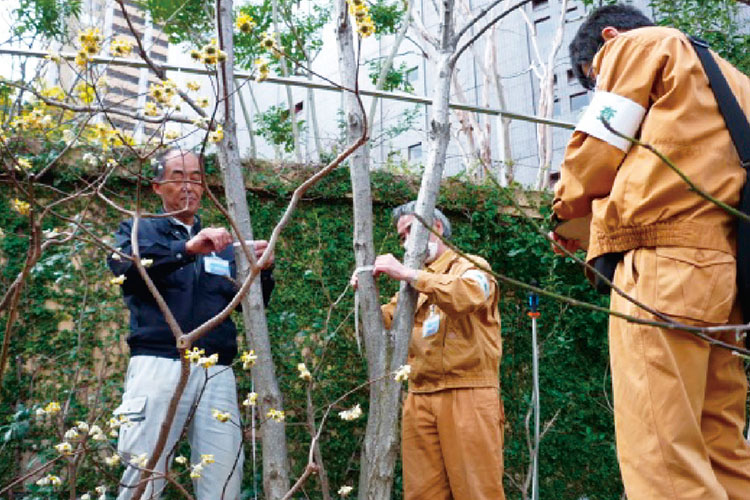
Signing of the Green Partner Agreement and the Osaka Biodiversity Partner Agreement, and their activities
In 2009, we signed a Green Partner Agreement with Osaka Prefecture, targeting the entire areas along our railway lines to promote greenery and the preservation of nature. We have been promoting environmental preservation activities ever since, including in Kyousei no Mori (Sakai City) and the biotope at the Tanagawa District (Misaki Town, Sennan County).
In March 2014, our company, Osaka Prefecture, Misaki Town, and the Research Institute of Environment, Agriculture and Fisheries, Osaka Prefecture also signed the Osaka Biodiversity Partner Agreement.

Kyousei no Mori
Osaka Prefecture has been reorganizing 100 ha of Sakai City’s coastal Sakai 7-3 District (approximately 280 ha), which is the final industrial waste treatment district, positioning it as “Kyousei no Mori (a forest for living in harmony).” Since FY2008, we have been taking part in a tree-planting festival (March) and grass-cutting event (September) for forestation, and have been making donations using our shareholder benefits system. We also hold a Kyousei no Mori Offsetting Event to offset the carbon emitted by the participants and staff of the two events as they travel (total of five tons from the two events). Nankai Electric Railway’s credits can be used to offset the carbon.
In FY2022, 150 people participated in the event, offsetting one ton of carbon emissions.
Tanagawa Biotope
Tanagawa Biotope* is a space in Ikiiki Park Misaki, which is managed by Osaka Prefecture and other parties, that aims to recreate a lush natural environment. Once a month, the employees of our company and Osaka Prefecture, and Misaki Town engage in environmental preservation activities there, such as taking care of the plants and pond, and observing creatures in the biotope. As shown in the photo, the place was quite barren in 2005, but turned into a lush biotope by 2013 after some work was done on it.
In FY2023, forest nature walks were held in the biotope in November. The nature observation events, which are held several times a year, included hiking in the Tanakawa Biotope.
*Tanagawa Biotope: a biotope (a space that preserves the original ecosystem of living things) within Ikiiki Park Misaki, the site that provides the earth and sand for the second phase construction of Kansai International Airport
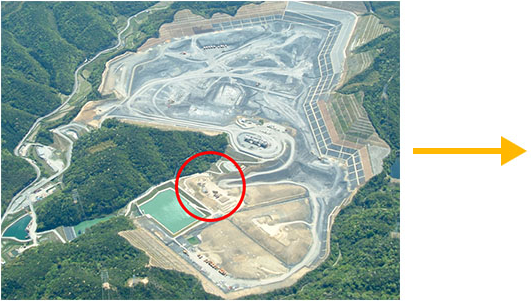
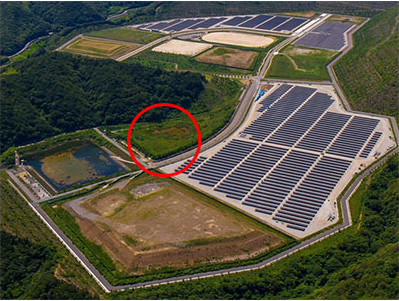
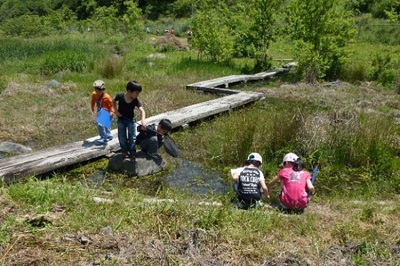
Sustainability Site Map
(materiality)
- Major sustainability themes (materiality)
- Identification processes
- Further seek safety, security, and satisfaction
- Thriving and friendly community development
- Create a future full of dreams
- Achieve an enriched life
- Develop a workplace and staff in a way that enables each person to put their abilities to use
-
Contribute to preserving the global environment
- Environmental philosophy
- Reducing CO2 emissions in response to climate change, promoting the use of renewable energy, and so forth
- Bringing about a circular society
- Preserving biodiversity
- Deepening our environmental management
- Expanding environmental buildings (green buildings)
- Responses to TCFD Recommendations
- Bolster a corporate foundation that is sincere and fair
